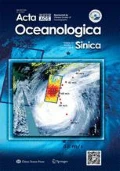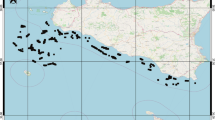Abstract
An extreme persistent cold anomaly was prevailing in the South China Sea in February 2008. In order to understand the effect of the cold anomaly on zooplankton community, the zooplankton composition, abundance and biomass were analyzed in the northern South China Sea in August 2007 and August 2008. A total of 467 zooplankton species representing 16 groups were identified, with 275 species in August 2007 and 351 in August 2008. Copepods were the most dominant zooplankton group in the study area. Compared with 2007, a dramatic decline was observed in the abundance of four dominant copepod species: Subeucalanus subcrassus, Temora discaudata, Nannocalanus minor and Temora turbinata in 2008. Moreover, zooplankton abundance declined from 133.37 ind./m3 in August 2007 to 75.49 ind./m3 in August 2008. In contrast, the abundance of medusa, such as Diphyes chamissonis, and tunicate, such as Doliolum denticulatum and Dolioletta gegenbauri, increased during the same season. Cluster analysis showed that there was a difference in zooplankton community structure between the two years. These variations in zooplankton communities were indicative of an anomalous oceanographic condition along with the extreme cold event in 2008.
Similar content being viewed by others
References
Alldredge A L, Madin L P. 1982. Pelagic tunicates: unique herbivores in the marine plankton. BioScience, 32(8): 655–663
Beaugrand G, Ibanez F. 2004. Monitoring marine plankton ecosystems: II. long-term changes in North Sea calanoid copepods in relation to hydro-climatic variability. Marine Ecology Progress Series, 284: 35–47
Chen Qingchao, Zhang Shuzhen. 1965. The planktonic copepods of the Yellow Sea and the East China Sea: I. Calanoida. Studia Marina Sinica (in Chinese), (7): 20–123
Chen Qingchao, Zhang Shuzhen. 1974a. The pelagic copepods of the South China Sea: I. Studia Marina Sinica (in Chinese), (9): 101–116
Chen Qingchao, Zhang Shuzhen. 1974b. The pelagic copepods of the South China Sea: II. Studia Marina Sinica (in Chinese), (9): 125–137
Chen Qingchao, Zhang Shuzhen, Zhu Changshou. 1974. The planktonic copepods of the Yellow Sea and the East China Sea: II. Cyclopoida and Harpacticoida. Studia Marina Sinica (in Chinese), (9): 27–76
Chertoprud E S, Gheerardyn H, Gómez S. 2011. Harpacticoida (Crustacea: Copepoda) of the South China Sea: faunistic and biogeographical analysis. Hydrobiologia, 666(1): 45–57
Clarke K R, Warwick R M. 1994. Change in marine communities: an approach to statistical analysis and interpretation. Plymouth: Plymouth Marine Laboratory
Dippner J W, Hänninen J, Kuosa H, et al. 2001. The influence of climate variability on zooplankton abundance in the Northern Baltic Archipelago Sea (SW Finland). ICES Journal of Marine Science, 58(3): 569–578
Flood P R, Deibel D, Morris C C. 1992. Filtration of colloidal melanin from sea water by planktonic tunicates. Nature, 355(6361): 630–632
González H E, Sobarzo M, Figueroa F, et al. 2000. Composition, biomass and potential grazing impact of the crustacean and pelagic tunicates in the northern Humboldt Current area off Chile: differences between El Niño and non-El Niño years. Marine Ecology Progress Series, 195: 201–220
Graham W M, Pagès F, Hamner W M. 2001. A physical context for gelatinous zooplankton aggregations: a review. Hydrobiologia, 451(1–3): 199–212
Hays G C, Richardson A J, Robinson C. 2005. Climate change and marine plankton. Trends in Ecolgy & Evolution, 20(6): 337–344
Hays S. 2006. Marine ecology: gelatinous bells may ring change in marine ecosystems. Current Biology, 16(17): R679–R682
Hong C C, Li T. 2009. The extreme cold anomaly over Southeast Asia in February 2008: roles of ISO and ENSO. Journal of Climate, 22(13): 3786–3801
Hooff R C, Peterson W T. 2006. Copepod biodiversity as an indicator of changes in ocean and climate conditions of the northern California current ecosystem. Limnology and Oceanography, 51(6): 2607–2620
Hwang J S, Dahms H U, Tseng L C, et al. 2007. Intrusions of the Kuroshio current in the northern South China Sea affect copepod assemblages of the Luzon Strait. Journal of Experimental Marine Biology and Ecology, 352(1): 12–27
Hwang J S, Kumar R, Dahms H U, et al. 2010. Interannual, seasonal, and diurnal variations in vertical and horizontal distribution patterns of 6 Oithona spp. (Copepoda: Cyclopoida) in the South China Sea. Zoological Studies, 49(2): 220–229
Jiménez-Pérez L C, Lavaniegos B E. 2004. Changes in dominance of copepods off Baja California during the 1997–1999 El Niño and La Niña. Marine Ecology Progress Series, 277: 147–165
Kaufmann R K, Kauppi H, Mann M L, et al. 2011. Reconciling anthropogenic climate change with observed temperature 1998–2008. Proceedings of National Academy of Sciences of the United States of America, 108(29): 11790–11793
Kleppel G S. 1993. On the diets of calanoid copepods. Marine Ecology Progress Series, 99: 183–195
Lavaniegos B E, Jiménez-Pérez L C, Gaxiola-Castro G. 2002. Plankton response to El Niño 1997–1998 and La Niña 1999 in the southern region of the California Current. Progress in Oceanography, 54(1–4): 33–58
Li Chunhou, Jia Xiaoping, Cai Wengui. 2004. Diversity of marine zooplankton in the north of South China Sea. Journal of Fishery Sciences of China (in Chinese), 11(12): 139–146
Li Kaizhi, Yin Jianqiang, Huang Liangmin, et al. 2006. Spatial and temporal variations of mesozooplankton in the Pearl River estuary, China. Estuarine Coastal and Shelf Science, 67(4): 543–552
Liu Ruiyu. 2008. Checklist of Marine Biota of China Seas (in Chinese). Beijing: Science Press, 608–635
Liu Huaxue, Song Xingyu, Huang Liangmin, et al. 2009. Phytoplankton biomass and Primary production in the northern South China Sea during summer, 2007 (in Chinese). In: Proceeding of Ocean Observations in the northern South China Sea. Guangzhou: South China Sea Institute of Oceanography, China Academy of Science, 515–521
Lynam C P, Gibbons M J, Axelsen B E, et al. 2006. Jellyfish overtake fish in a heavily fished ecosystem. Current Biology, 16(13): R492–R493
Mackas D L, Beaugrand G. 2010. Comparisons of zooplankton time series. Journal of Marine Systems, 79(3–4): 286–304
McKinnon A D, Duggan S, Carleton J H, et al. 2008. Summer planktonic copepod communities of Australia's North West Cape (Indian Ocean) during the 1997–99 El Niño/La Niña. Journal of Plankton Research, 30(7): 839–855
Perlwitz J, Hoerling M, Eischeid J, et al. 2009. A strong bout of natural cooling in 2008. Geophysical Research Letters, 36(23): L23706
Purcell J E, Arai M N. 2001. Interactions of pelagic cnidarians and ctenophores with fish: a review. Hydrobiologia, 451(1–3): 27–44
Purcell J E, Uye S I, Lo W T. 2007. Anthropogenic causes of jellyfish blooms and their direct consequences for humans: a review. Marine Ecology Progress Series, 350: 153–174
Qiu J. 2011. Marine science: China’s unsinkable scientist. Nature, 469(7331): 460–461
Roemmich D, McGowan J. 1995. Climatic warming and the decline of zooplankton in the California current. Science, 267(5202): 1324–1326
Sommer F, Stibor H, Sommer U, et al. 2000. Grazing by mesozooplankton from Kiel Bight, Baltic Sea, on different sized algae and natural seston size fractions. Marine Ecology Progress Series, 199: 43–53
Song Xingyu, Liu Huaxue, Huang Liangmin, et al. 2010. Distribution characteristics of basic biological production and its influencing factors in the northern South China Sea in summer. Acta Ecologica Sinica (in Chinese), 30(23): 6409–6417
Stibor H, Vadstein O, Lippert B, et al. 2004. Calanoid copepods and nutrient enrichment determine population dynamics of the appendicularian Oikopleura dioica: a mesocosm experiment. Marine Ecology Progress Series, 270: 209–215
Su Jilan. 2004. Overview of the South China Sea circulation and its influence on the coastal physical oceanography outside the Pearl River Estuary. Continental Shelf Research, 24(16): 1745–1760
Tan Yehui, Huang Liangmin, Chen Qingchao, et al. 2004. Seasonal variation in zooplankton composition and grazing impact on phytoplankton standing stock in the Pearl River Estuary, China. Continental Shelf Research, 24(16): 1949–1968
Trenberth K E, Fasullo J T. 2010. Tracking Earth's energy. Science, 328(5976): 316–317
Tseng L C, Kumar R, Dahms H U, et al. 2008. Copepod community structure over a marine outfall area in the northeastern South China Sea. Journal of the Marine Biological Association UK, 88: 955–966
Vargas C A, González H E. 2004. Plankton community structure and carbon cycling in a coastal upwelling system: I. Bacteria, microprotozoans and phytoplankton in the diet of copepods and appendicularians. Aquatic Microbial Ecology, 34(2): 151–164
Wang Xiaoling, Guo Yanjun. 2009. Global significant weather and climate events in 2008. Meteorological Monthly (in Chinese), 35(4): 108–111
Wheeler M C. 2008. Seasonal climate summary southern hemisphere (summer 2007-08): mature La Niña, an active MJO, strongly positive SAM, and highly anomalous sea-ice. Australian Meteorological Magazine, 57: 379–393
Wiafe G, Yaqub H B, Mensah M A, et al. 2008. Impact of climate change on long-term zooplankton biomass in the upwelling region of the Gulf of Guinea. ICES Journal of Marine Science, 65(3): 318–324
Xian Yile, Zhong Jinshui, Huang Wenqin, et al. 2008. The impacts from cold event in Penghu fishery resources. (in Chinese). In: Proceedings of marine ecological and fishery resources after the cold disaster in Penghu. Keelung: Fisheries Research Institute, 43–71
Xu Zhaoli, Chen Yaqu. 1989. Aggregated intensity of dominant species of zooplankton in autumn in the East China Sea and Yellow Sea. Journal of Ecology (in Chinese), 8(4): 13–15
Zhang Wuchang, Tang Danling, Yang Bo, et al. 2009. Onshore-offshore variations of copepod community in northern South China Sea. Hydrobiologia, 636(1): 257–269
Zhang G T, Wong C K. 2011. Changes in the planktonic copepod community in a landlocked bay in the subtropical coastal waters of Hong Kong during recovery from eutrophication. Hydrobiologia, 666(1): 277–288
Author information
Authors and Affiliations
Corresponding author
Additional information
The National Natural Science Foundation of China under contract Nos 41506161 and 41276162; the National Basic Research Program (973 Program) of China under contract No. 2015CB452903; the Strategic Priority Research Program of the Chinese Academy of Sciences under contract No. XDA11020305; the Special Fund for Agro-scientific Research in the Public Interest under contract No. 201403008.
Rights and permissions
About this article
Cite this article
Lian, X., Tan, Y., Huang, L. et al. Striking taxonomic differences in summer zooplankton in the northern South China Sea: implication of an extreme cold anomaly. Acta Oceanol. Sin. 36, 87–96 (2017). https://doi.org/10.1007/s13131-017-0975-5
Received:
Accepted:
Published:
Issue Date:
DOI: https://doi.org/10.1007/s13131-017-0975-5




